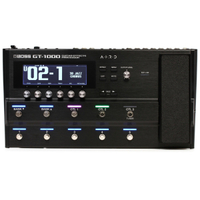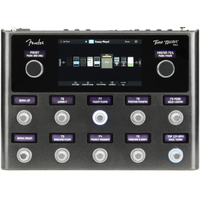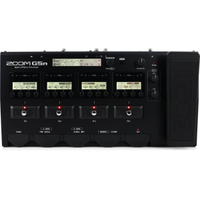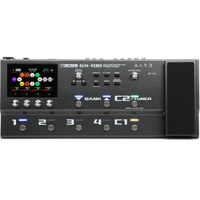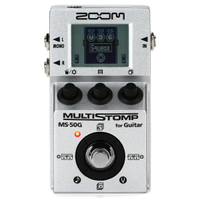Best multi-effects pedals 2024: Our pick of the best all-in-one guitar FX modellers
Our guide to the best multi-effects pedals will help you get your head around amp modelling pedals and multi-FX
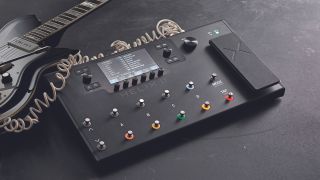
Many guitarists have contemplated reducing the size of their live rigs, with the epiphany usually occurring a quarter of the way up three flights on narrow stairs at your local venue with a tube amp in your hands. The temptation is made even easier in the modern world, as the best multi-effects don't just replace your pedalboard, but your rig in its entirety.
In 2024 there's a huge selection of options on offer from super-advanced profilers to simpler pedals that only replicate effects. Deciding what's best for you can be a tough call, and that's where we step in. Our team of musicians has reviewed a multitude of multi-effects over the years, giving us an excellent overview of what's truly useful to guitar players. We've run them through the gauntlet too, testing them at home, in the rehearsal room, at the studio, and on our own pedalboards for live shows to make sure our picks can cut the mustard in the real world. We'll test all of the various functionality from amps and effects modelling to using them as audio interfaces all in the name of finding the very best in the world today and presenting them right here for you.
So whether you want to augment your existing pedalboard with a wider variety of effects, or you want to get rid of your rig in its entirety, there's never been a better time to jump into the world of multi-effects. If you're new to these incredible pedals, then make sure to have a look at our buying advice section which features loads of common questions answered by the guitar gurus here at MusicRadar. If you already know your stuff, just keep scrolling for the best of the best...
- Looking for epic music gear bargains? We're tracking all of this year's biggest savings over on our Black Friday music deals page. If you’re in the market for some fresh guitar gear, check out our Black Friday guitar deals hub.
The quick list
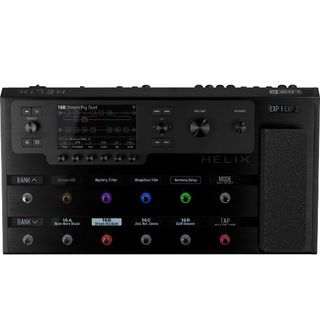
With a frankly colossal amount of amps, cabs, effects, presets, the ability to load your own IRs, and outstanding connectivity, it doesn't get much better than the Line 6 Helix.
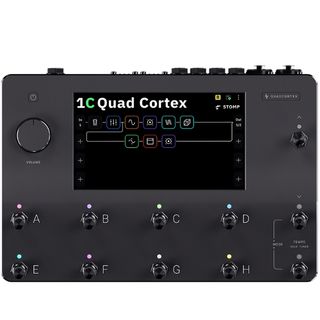
With it's huge amount of processing power, the Neural DSP Quad Cortex is one of the best in the game when it comes to accurately emulating amplifiers and effects.
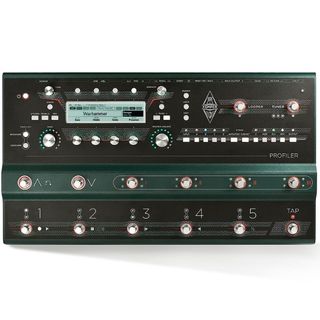
A multi-effects pedal that can replace your entire rig, the Kemper Profiler Stage is the choice of many a professional guitarist when it comes to ampless setups.
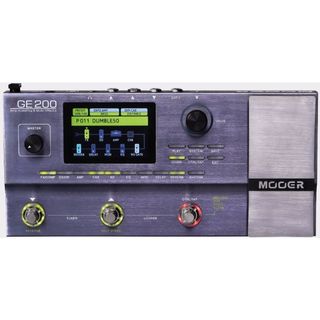
Mooer may not be the most well-known brand but the Mooer GE200 represents incredible value for money. If you need effects on a budget, it's a fantastic choice.
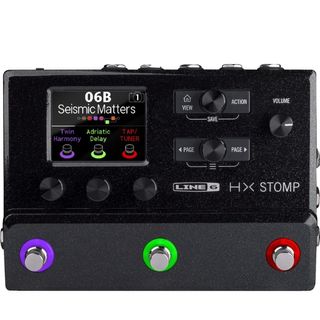
If you've got a full pedalboard already, then the Line 6 HX Stomp gives you all the power and versatility of HX effects in a much more compact format, perfect for live performances.
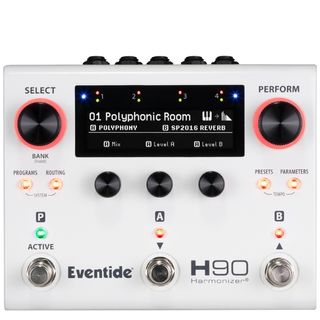
Looking for something different? The Eventide H90 Harmonizer features many less-than-usual effects for those who like to explore the cosmos of guitar effects.
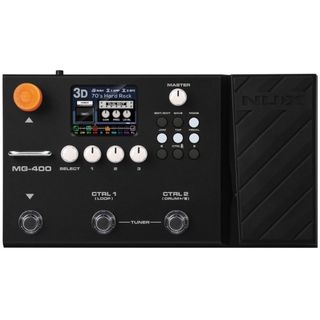
If you're looking for your first multi-effects pedal, the NUX MG-400 is a great choice, packing loads of quality amp tones and effects models into a user-friendly package.
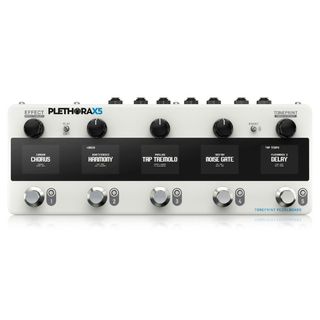
It doesn't feature any drive or distortion effects, but if you need something compact for your 'board, the TC Electronic Plethora X5 gives you loads of modulation and time-based effects.
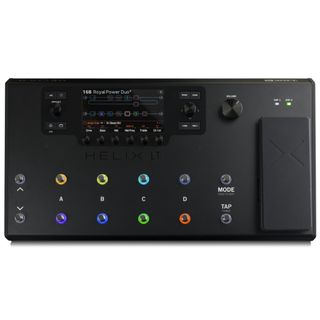
There aren't many multi-effects pedals for bass, but the Line 6 Helix LT is our top pick with its superb selection of amp models and expression pedal for controlling wah and filter effects.
Best overall





Specifications
Reasons to buy
Reasons to avoid
✅ Buy if you want a multi-effects all-rounder: With its huge amp selection and massive range of effects models, the Helix is our pick as the best overall multi-effects you can buy.
❌ Avoid if you like things simple: With so much choice and connectivity, this isn't one for those who suffer from option paralysis.
The dual-DSP-powered Helix combines amp and effects models in a large, rugged floor pedal. You'll find a not inconsiderable 1,024 presets loaded onto the Helix, split into eight setlists with 32 banks and four presets each. Each preset can have up to four stereo signal paths, each made up of eight blocks populated with amps and effects.
If it's sound creation you're after, then you have an absolute bounty of options to play with - the line-up includes 41 modelled amps, seven bass amps, 30 cabs, 16 microphones, 80 effects and the option to load up speaker impulse responses. Line 6 has implemented an easy editing system, complete with a joystick, and - get this - touch-sensitive footswitches offering a shortcut to parameter adjustment; you can even use these with your feet to select a parameter before adjusting it with the pedal treadle!
There are some great sounds here, especially when we got beyond the factory presets and shaped things to our own tastes. The Helix's advantage lies in its comprehensive input/output and signal routing ability, which can facilitate just about any guitar-related studio or onstage task you can think of. However, if you don't need all that connectivity, and want to save a bit of cash, there's also the Line 6 Helix LT which features further down this list.
Read our full Line 6 Helix review
Best modeller


Specifications
Reasons to buy
Reasons to avoid
✅ Buy if you want a pro-level multi-effects pedal: The amp models on the QC are simply unparalleled, making it a great choice for the player who wants a lot of choice and flexibility.
❌ Avoid if you're on a budget: This kind of tech doesn't come cheap, so avoid this if your budget is tight.
Harnessing the power of 2GHz Quad-Core SHARC DSP, the Neural DSP Quad Cortex is a supremely powerful tool for the pro guitar player. It’s not cheap, but there’s a reason many pro-guitar players are switching to this brilliant amp modeler slash profiler.
The processing power of the QC means that the quality of the effects and amp models is simply jaw-dropping. In a blind test we doubt many guitarists could tell the difference between the QC and the real deal, and when you add in the ability to model your own gear - you’ve got little reason not to make the switch to modeling.
The unit itself is compact yet extremely rugged, and we absolutely love the clever footswitch/rotary control hybrids, allowing the QC to stay smaller than the vast majority of competing amp modelers. Just imagine, all of your amps, cabs, and effects pedals in a unit no bigger than a laptop. Simply incredible stuff.
Read the full Neural DSP Quad Cortex review
Best profiler





Specifications
Reasons to buy
Reasons to avoid
✅ Buy if you want a pro-level profiler: The Kemper allows you to make models of your own amps and effects, making it a powerful choice for taking your regular rig on the road minus the weight and transport costs.
❌ Avoid if you're not tech-savvy: Operating the Kemper will require some proper manual diving, so not one for those who like their pedals simple to use.
The Kemper Profiler Stage is way more than just a multi-effects pedal. It replaces your rig entirely, giving you every amp and effect combination you could ever dream of. Coming in a handy pedalboard format, this powerful profiler could well be the last guitar purchase you ever make.
Pre-loaded with some of the finest amp models and effects ever made, everything here has been profiled in professional recording studios, ensuring you get the best sound possible. There are distortions, delays, choruses, and pretty much any other effect you can think of, all easily edited with Kemper’s Rig Manager app.
The unit itself is sturdily built, giving you plenty of reassurance that it will put up with a hectic touring schedule. A built-in looper and tuner offer extra functionality and you can plug in up to four expression pedals to modulate any parameter you like. Add in the wealth of connections on the back and you’ve got one of the most complete multi-effects pedals out there.
Read the full Kemper Profiler Stage review
Best budget option



4. Mooer GE200 Multi-Effects Pedal
Our expert review:
Specifications
Reasons to buy
Reasons to avoid
✅ Buy if you're on a tight budget: The Mooer GE200 is a fantastic option for players on a tight budget, giving you a lot of great sounds and functionality for relatively little.
❌ Avoid if you're regularly gigging: This isn't quite as rugged as some of the other units on this list, so probably not best for players who are regularly travelling with their multi-effects.
The Chinese brand Mooer has slowly but surely built itself a reputation for hitting the sweet spot between price and performance. What began as a brand offering low-cost versions of existing big-name pedals has grown to them now being considered a genuine contender in the low-to-mid range.
The Mooer GE200 is a great example, offering a selection of effects, models and tools that wouldn't look (or sound) out of place on a unit far higher up the effects food chain. The 70 included effects all sound great, and we particularly liked the ability to load your own impulse responses to fine-tune your speaker outputs. Very capable, and definitely worth your attention.
Best for live performance






Specifications
Reasons to buy
Reasons to avoid
✅ Buy if you're regularly playing live: With its small size, excellent amp selection, and fantastic connectivity, the HX Stomp is perfect for strapping onto a pedalboard and taking out on the road.
❌ Avoid if you don't like menu diving: It's a small screen with very few buttons, so you'll have to remember combinations to get the best out of it without the HX Edit app.
The HX Stomp contains over 190 effects, including the Helix, M Series and legacy Line 6 patches, as well as the amp, cab and mic options of the full-fat Helix. It supports loading of impulse responses, too, so if you've modelled your own amps, or purchased commercial IRs from somewhere else, they can be loaded into the pedal too.
Cramming not only the sounds of those units, but also a full-colour screen into a unit the size of the HX Stomp is certainly impressive and no mean feat. With MIDI in and out, there’s clearly been some consideration for those that want to incorporate the HX Stomp into a rig controlled by a pedal switcher. In that context, it’s easy to see the attraction.
Though the HX Stomp is limited in terms of its controls on the front, it’s highly customisable, and offers a broad palette of professional-grade effects to explore. For the guitarist that wants specific modulations, delays or a cab sim on tap ‘just in case,’ the HX Stomp is a smart, compact solution, and the capacitive footswitches make assigning and editing a relatively error-free procedure - it’s unlikely you’ll need to refer to the manual much at all. And if you don't need the amp models and fancy a few more footswitches, there's also the HX Effects.
Read our full Line 6 HX Stomp review
Best creative option







Specifications
Reasons to buy
Reasons to avoid
✅ Buy if you want more 'out-there' effects: The H90 has some properly wacky effects that are perfect for guitar players of the experimental variety.
❌ Avoid if you need amp modelling: The H90 only does effects, there's no amp modelling here so not an option for replacing your full rig.
The Eventide H90 Harmonizer is the follow-up to the cult classic Eventide H9, of which many could be found on pro guitarists’ pedalboards. Loads of guitarists were adding two H9s to their ‘boards to make the most out of the amazing algorithms on board, so it made sense for the next iteration that Eventide would essentially stick two H9s together in one unit.
The H90 does an amazing job of marrying your more run-of-the-mill delays and reverbs with some of the weirder pitch-shifting effects to make something that’s perfect for the sonic explorers. If you feel like you’ve tried every effect out there and nothing is quite cutting it for you, then this powerful bit of kit might be the perfect choice.
There’s an incredible array of routing options for integrating it into your rig, and you can select which effects you want to run before or after your amplifier for extra flexibility. As well as being an incredibly powerful tool for guitarists, it’s also right at home in the studio thanks to its excellent editing app.
Read the full Eventide H90 Harmonizer review
Best for beginners
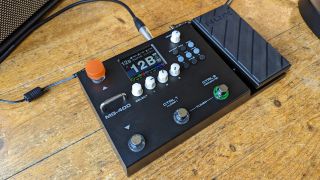
Specifications
Reasons to buy
Reasons to avoid
✅ Buy if you're a first-timer: With its low cost and superb selection of amps and effects, the MG-400 is a great option for beginner guitar players who want their first multi-effects.
❌ Avoid if you don't like tweaking: To get the best out of it you'll want to tweak the tones from the presets, so avoid if you want straight out-of-the-box usability.
If you've been following the rise of NUX, then you'll know they pride themselves on making everything from amplifiers to electronic drum kits accessible to everyone - and that extends to multi-effects units.
The newly released MG-400 is their latest pedal, and frankly, it may be their best unit yet. This value-packed modeller builds on what NUX established with the MG-300 and is powered by their flagship White-Box Amp Modeling algorithm.
Better yet, the new MG-400 introduces scene functionality which allows you to set up "snapshots" within a preset, for easy recall of multiple effects - perfect for gigging guitar players! For us, the NUX MG-400 is an insanely powerful multi-effects unit that certainly outperforms its price range.
Read our full NUX MG-400 review
Best compact option




Specifications
Reasons to buy
Reasons to avoid
✅ Buy if you want to add to a pedalboard: Covering a huge range of delays, reverbs, and modulation effects, the Plethora is a great choice if you just want to add more effects to your pedalboard for live playing.
❌ Avoid if you need modelled drive and distortion: There's no drives or distortions here, so avoid if that's what you're looking for from your multi-effects pedal.
The TC Electronic Plethora X5 takes some of the company’s best TonePrint pedals and puts them all in one handy unit for you. It comes at a very reasonable price too, considering the number of effects you get.
Chain up to five pedals together including some stone-cold classics like the Flashback delay and Hall of Fame Reverb, as well as a bunch of other modulation and more workhorse effects like a noise gate and compressor. You can stack multiples of the same pedal, although you may run into artifacts with too many.
You can then store your chain as a ‘scene’, giving you a different flavor of tone for each song in your setlist. TC Electronic has also added more pedals via firmware since its launch, so there’s potential for powerful upgrades in the future too.
Read the full TC Electronic Plethora X5 review
Best for bass
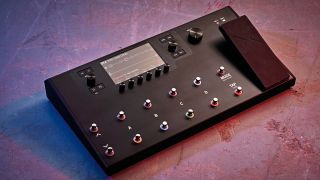
Specifications
Reasons to buy
Reasons to avoid
✅ Buy if you want a multi-effects pedal for bass: With a huge selection of some of the best bass amps in the world, the Helix LT is a great option for bass (and guitar) players.
❌ Avoid if you need something compact: This pedal is pretty large, so one to avoid if you need something you can just chuck into a backpack.
There are not that many dedicated multi-effects pedals for bass guitar players and while the Line 6 Helix LT is primarily aimed at guitarists, it also features an excellent selection of bass amp models for four and five-string players.
There are 17 different bass amp models, with official Ampeg models as they're a sub-brand of Yamaha Guitars. You also get some fantastic models based on Fender, Mesa/Boogie, Galien-Kreuger, Orange, and Aguilar amps, plenty to satisfy even the most tone-hungry bassist.
Add in more effects than we could count, and you've got a superbly versatile bass rig. With plenty of octave effects for super low rumbling tones, synth sounds when you're feeling more esoteric, envelope filters, delays, chorus, and many other modulation effects, you can generate pretty much any tone you think of with the Helix LT.
Read our full Line 6 Helix LT review
Also tested
The multi-effects pedals listed above are the ones we reckon you should spend your cash on, but if you didn't find what you were looking for, we've reviewed loads more here.
Boss GT-1000 | 16 amp models | 116 effects
After the success of the 500 series units, Boss's GT-1000 floorboard combines all three. Sleek and modern, it's a formidably robust beast. To the rear, there’s the usual array of inputs and outputs, including USB recording out and an input for an additional expression pedal.
MusicRadar Score: 4.5/5
Read our full Boss GT-1000 review
Fender Tone Master Pro | 27 amp models | 82 effects
Fender’s modeling offering is a versatile one, with their signature glassy clean present and accounted for as well as plenty more on offer. From British-style amp voicings to the higher gain tones of the EVH series you won’t be shy of sounds to choose from here.
MusicRadar Score: 4.5/5
Read our full Fender Tone Master Pro review
Zoom G5n | 10 amp models | 68 effects
Packing in 68 digital effects, 10 amp and cabinet emulators, and a stereo looper with up to 80 seconds of looping time, the Zoom G5n is a worthy option for beginners or anyone looking to expand their options.
MusicRadar Score: 4/5
Read our full Zoom G5n review
Boss GX-100 | 23 amp models | 150 effects
Coming in at around half the price of the flagship GT-1000, the Boss GX-100 certainly doesn’t offer half the performance. This is a professional-level multi-effects, with an intermediate price tag. This sleek and stylish unit houses an impressive 23 amp models and 150 effects.
MusicRadar Score: 4.5/5
Read our full Boss GX-100 review
Zoom MS-50G MultiStomp | 22 amp models | 100+ effects
Following a raft of recent updates, the MS-50G now boasts over 100 effects and 22 amp models, six of which can be used simultaneously in any order. Add a chromatic tuner into the equation, and you're looking at a pedal for all seasons.
MusicRadar Score: 4/5
Read our full Zoom MS-50G MultiStomp review
Buying advice
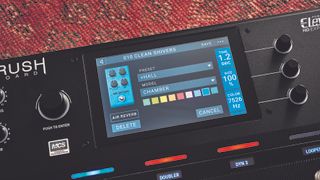
What should I look for in a multi-effects pedal?
If there's one thing you've got when choosing the best multi-effects pedal for you, it's a wide selection. As with anything, your allocated budget will dictate which end of the spectrum you'll end up at, but there’s plenty of choice, from enormous 'studio-in-a-box' type units, to small form-factor pedals that pack a handful of essential effects onto your pedalboard. Here are some things to consider.
How many effects is too many?
We've all seen examples of someone firing up a multi-effects unit, blasting through the presets like a kid in a sweetshop, but it’s crucially important to consider the types of effects you'll actually use.
Be realistic with yourself, because it’s likely you’ll settle on a small handful of the best guitar effects. Would you be better served looking for a smaller, more capable unit to handle the effects you use the most? Or do you absolutely need the spaceship-looking behemoth full of wacky sounds?
The alternative theory is that, occasionally, you can stumble on something you've never used before and it can spark your creativity. This definitely happens, and is a happy side benefit of having so many effects at your beck and call. For a beginner, the sub-$200 range has plenty to get you excited.
If packing in as many effects as you can into a single box is your aim, you'll find plenty of options to choose from at all ends of the price scale. From budget options like the smaller Zoom pedals, through to entry-level versions of the pro models from the big names in effects like Boss and Line 6.
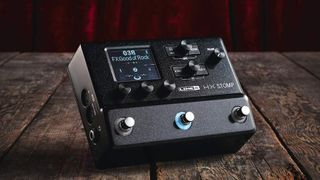
What do I get if I spend a bit more?
As you move up the range, you'll start to see extra features and functionality like loopers, hardened chassis models and extra connectivity. It's not uncommon now for multi-effects to link with apps on your smart device, where you can get in for deep editing of parameters and settings.
Also common nowadays is for a multi-effects unit to double up as an audio interface or amp modeller. These USB-enabled devices can be plugged into one of the best laptops for music production, allowing you to record songs into a digital audio workstation (DAW) like Ableton Live or Pro Tools.
As ever though, our advice is simple. Work out what you'll realistically want, need or use. Be clear on your budget. Don't be distracted by extra bells and whistles - unless that’s what you want.
Are multi-effects pedals worth it?
It all depends on what you value when it comes to guitar. There are many guitarists who prefer a traditional pedalboard layout. You can tweak each pedal individually without menu diving, reorder them at will, or replace them whenever you feel like something isn’t working.
However with a multi-effects unit, you’ve got less chance of failure due to bad patch cables or faulty pedalboard power supplies, less to carry around, and they’re usually cheaper when you take into account the cost of some individual pedals.
In terms of pure value for money, we’d argue that yes, multi-effects pedals are worth the investment. You get much more bang for your buck with a multi-effects pedal, at the expense of some ease of use.
How we test
How do we test a multi-effects pedal?
Testing out a multi-effects pedal is a fairly straightforward procedure, and similar to testing a standalone stompbox. Although the quality of pedals is subjective - like many pieces of musical equipment - there is a set of criteria that every pedal should meet before we recommend it to anyone.
We'll first start with the build quality of the enclosure, controls and footswitch. Pedals are designed to be stood on, so we need to ensure that the enclosure and footswitch feel robust, solid and able to withstand being stamped on. We then check the quality of the dials, making sure that they have a smooth action with enough resistance to reduce accidental movement.
We also check to see how well spaced out and easy to use the footswitches are. We'll also check the expression pedal if there is one, and make note of its action and usability. Multi-effects pedals are here to make your lives easier, after all.
We then test the pedals sonically, and much like our amp testing procedures, we start with every dial in the middle '12 o'clock' position. We then tweak each dial towards a tone we would usually go for - and make sure that we experiment with the full range of sounds on offer. We'll then check any amp or effect emulations or presets. We'll cycle through those, while editing a few as we go to see how easy the process is (or isn't).
Read more about how we test music making gear and services at MusicRadar.
Related buyer's guides
MusicRadar's got your back
- The best distortion pedals for every budget
- The best looper pedals you can buy right now
- The best guitar plugins to supercharge your guitar recordings
- Take a look at some of the best gifts for guitarists
- The best pedalboard power supplies
- On a tight budget? Here are the best cheap guitar pedals
![Eric Clapton and his gold-plated Cry Baby: [Left] a black and white image of Clapton playing his Bigsby-equipped Gibson Les Paul standard live on stage with Cream.](https://vanilla.futurecdn.net/cyclingnews/media/img/missing-image.svg)
“We are honoured that our company’s relationship with the legendary guitar player continues to this day”: Dunlop salutes wah pedal pioneer Eric Clapton with a gold-plated signature Cry Baby

“Honestly I’d never even heard of Klons prior to a year-and-a-half ago”: KEN Mode’s Jesse Matthewson on the greatest reverb/delay ever made and the noise-rock essentials on his fly-in pedalboard
Get the MusicRadar Newsletter
Want all the hottest music and gear news, reviews, deals, features and more, direct to your inbox? Sign up here.
James is a freelance writer and former Junior Deals Writer at MusicRadar. Before writing, James worked as a guitar salesman at a local music store, so he knows a thing or two about matching people with their perfect instruments. James also has experience working in other areas of the music trade, having worked for the online music distributor, RouteNote. James is a guitarist, bassist and drummer and has also toured the UK and Europe with his old band Hypophora.
- Matt McCrackenJunior Deals Writer
- Alex Lynham
- Daryl RobertsonSenior Deals Writer
![Eric Clapton and his gold-plated Cry Baby: [Left] a black and white image of Clapton playing his Bigsby-equipped Gibson Les Paul standard live on stage with Cream.](https://vanilla.futurecdn.net/cyclingnews/media/img/missing-image.svg)
“We are honoured that our company’s relationship with the legendary guitar player continues to this day”: Dunlop salutes wah pedal pioneer Eric Clapton with a gold-plated signature Cry Baby

“Honestly I’d never even heard of Klons prior to a year-and-a-half ago”: KEN Mode’s Jesse Matthewson on the greatest reverb/delay ever made and the noise-rock essentials on his fly-in pedalboard
